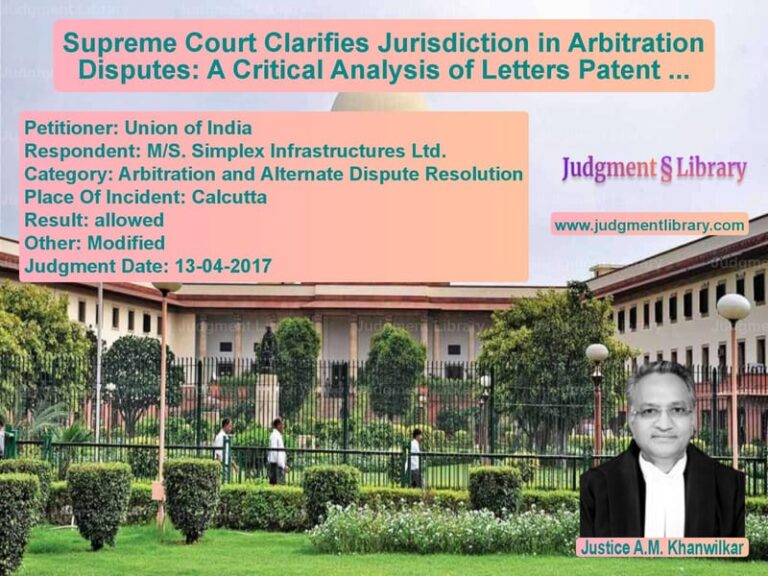Supreme Court Acquits Husband in 1990 Kolhapur Murder Case
The case of Sadashiv Dhondiram Patil vs. The State of Maharashtra revolves around a long-standing murder trial in which the appellant was accused of killing his wife, Lata, in their home in 1990. Initially acquitted by the Trial Court in 1993, the Bombay High Court overturned the verdict in 2015 and convicted him under Sections 302 and 201 of the Indian Penal Code (IPC). The Supreme Court, in its 2025 ruling, set aside the conviction, emphasizing the lack of credible evidence.
This judgment reinforces the principle that circumstantial evidence must be strong and unequivocal to warrant a conviction, especially in cases where an extra-judicial confession forms the core of the prosecution’s case.
Background of the Case
The prosecution alleged that the appellant, Sadashiv Patil, murdered his wife Lata due to suspicions about her fidelity. The deceased went missing, and later, her body was discovered in a corner of their home. The case against the appellant was built on circumstantial evidence, including an alleged extra-judicial confession and the discovery of an iron rod, the purported murder weapon.
Chronology of Events
- October 25, 1990: Lata was reported missing, and her body was later found in her home.
- October 29, 1990: The appellant allegedly made an extra-judicial confession before the village police patil.
- 1993: The Trial Court acquitted the appellant due to insufficient evidence.
- 2015: The Bombay High Court overturned the acquittal, convicting the appellant and sentencing him to life imprisonment.
- 2025: The Supreme Court reviewed the case and reinstated the acquittal.
Prosecution’s Case
The prosecution built its case on four key circumstantial elements:
- Extra-judicial confession: The appellant allegedly confessed to the crime before a village police patil.
- Discovery of the murder weapon: An iron rod was recovered based on information provided by the appellant.
- Motive: The appellant suspected his wife of infidelity.
- Location of the crime: The crime occurred in the appellant’s home, implying he had exclusive knowledge of the events.
Petitioner’s Arguments
The appellant, represented by his counsel, contended that:
- The High Court wrongly relied on an extra-judicial confession, which was vague and uncorroborated.
- The confession, allegedly made to a village police patil, was inadmissible under Section 25 of the Indian Evidence Act.
- The discovery of the iron rod was not credible as the panch witnesses did not support the prosecution’s version.
- The prosecution failed to establish a clear motive beyond mere suspicion.
Respondent’s Arguments
The State of Maharashtra, through its counsel, countered that:
- The extra-judicial confession was voluntarily made and reliable.
- The accused’s failure to explain the death of his wife within their home shifted the burden under Section 106 of the Evidence Act.
- The discovery of the iron rod corroborated the prosecution’s theory.
- The motive was clear, as the appellant suspected his wife of infidelity.
Supreme Court’s Analysis
Key Observations
- “An extra-judicial confession should be free from any inducement, coercion, or undue influence.”
- “The alleged confession was vague and lacked specificity, failing to inspire confidence.”
- “The prosecution must prove its case beyond a reasonable doubt; suspicion, however strong, cannot substitute proof.”
- “The High Court erred in shifting the burden to the accused without first establishing a prima facie case.”
Validity of Extra-Judicial Confession
The Court found that:
- The confession was made to a village police patil, whose legal status as a police officer was debated.
- Even if admissible, the confession lacked specificity and was not corroborated by other evidence.
- Past Supreme Court rulings have held that extra-judicial confessions are weak evidence and require corroboration.
Absence of Reliable Forensic Evidence
The Supreme Court noted:
- The iron rod allegedly used in the murder was recovered from the accused’s home, but no forensic evidence linked it to the crime.
- Panch witnesses turned hostile, weakening the prosecution’s case.
- The absence of forensic linkage raised serious doubts about the prosecution’s narrative.
Final Judgment
The Supreme Court ruled as follows:
- The Bombay High Court’s conviction was set aside, and the appellant’s acquittal was restored.
- The extra-judicial confession was deemed unreliable and inadmissible.
- The prosecution failed to prove guilt beyond a reasonable doubt.
- The appellant was released immediately, and his bail bonds were discharged.
Implications of the Judgment
This ruling has significant implications for criminal law:
- Reaffirms the principle that circumstantial evidence must be conclusive.
- Sets a high standard for relying on extra-judicial confessions.
- Protects accused persons from wrongful convictions based on suspicion.
- Clarifies the burden of proof under Section 106 of the Evidence Act.
Conclusion
The Supreme Court’s decision in this case reinforces the fundamental principle that an accused is innocent until proven guilty beyond a reasonable doubt. By overturning the High Court’s conviction and restoring the acquittal, the ruling ensures that wrongful convictions based on unreliable confessions and weak circumstantial evidence do not stand.
Petitioner Name: Sadashiv Dhondiram Patil.Respondent Name: The State of Maharashtra.Judgment By: Justice J.B. Pardiwala, Justice R. Mahadevan.Place Of Incident: Kolhapur, Maharashtra.Judgment Date: 09-01-2025.
Don’t miss out on the full details! Download the complete judgment in PDF format below and gain valuable insights instantly!
Download Judgment: sadashiv-dhondiram-p-vs-the-state-of-maharas-supreme-court-of-india-judgment-dated-09-01-2025.pdf
Directly Download Judgment: Directly download this Judgment
See all petitions in Murder Cases
See all petitions in Bail and Anticipatory Bail
See all petitions in Custodial Deaths and Police Misconduct
See all petitions in Judgment by J.B. Pardiwala
See all petitions in Judgment by R. Mahadevan
See all petitions in allowed
See all petitions in Quashed
See all petitions in supreme court of India judgments January 2025
See all petitions in 2025 judgments
See all posts in Criminal Cases Category
See all allowed petitions in Criminal Cases Category
See all Dismissed petitions in Criminal Cases Category
See all partially allowed petitions in Criminal Cases Category







